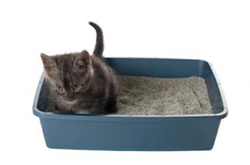
ANIMAL RESCUE AND ADOPTION TEAM INC.
Litter Box Training Tips
~ Litter Box Do’s & Don’ts ~
For some cats, elimination outside of the litter box may be the first sign of a health problem that requires veterinary treatment.
For others, inappropriate elimination may be a sign of stress or frustration.
For still others, failure to use the litter box may be an indication that there is something wrong with the box or its contents.
LITTER-TRAINING CATS
A cat doesn’t need to be taught what to do with a litter box. The only thing you need to do is provide an acceptable, accessible litter box. It is not recommended that you take a cat to the box and move his paws back and forth in the litter. This may actually be an unpleasant experience for the cat and may initiate “bad” associations with the litter box. If you provide him with acceptable, accessible litter, he’ll know what it’s for. Never punish a cat for making a mess outside of its litter box. Punishment usually makes things worse or creates other problems such as fear of the owner, especially if you swat your cat or rub its nose in the mess.
STARTING OUT RIGHT WITH THE LITTER BOX
Litter boxes that do not provide an acceptable place to eliminate may cause a cat to go to the bathroom somewhere else. It’s important to provide a litter box that meets your cat’s needs so that he/she will like the box and use it consistently. Remember that what is acceptable and accessible must be determined from the cat’s point of view, not your view. Provide a box that is large enough for your cat. Few cats will use a small litter box. Some cats also dislike covered litter boxes. Replace the litter box when the bottom becomes rough and worn from use (a worn litter box retains odors that cats may find offensive).
TO COVER OR NOT TO COVER
Many cats will not show any preference for a covered versus an uncovered box. However, if you have a large cat, a covered box may not allow him sufficient room to turn around, scratch and dig, and position himself in the way he wants. A covered box may also make it easier for another cat to lay in wait and “ambush” the user as he exits the box. On the other hand, a covered box tends to provide more privacy and may be preferred by timid, shy cats. You may need to experiment, and offer both types at first to discover what your cat prefers.
LOCATION OF LITTER BOX
Often, the litter box may end up in the basement, possibly next to an appliance, on an unfinished, cold cement floor. This type of location may be undesirable from the cat’s point of view. Cats may be startled while using the box if a furnace or washer/dryer suddenly turns on and that may be the last time they’ll risk such a frightening experience! Some cats like to scratch the surface surrounding their litter box and may find a cold cement floor unappealing. If the box sits on a smooth, slick or cold surface, put a rug underneath the box.
A young, small kitten may not be able to get down a long flight of steep stairs in time to go to the bathroom – especially if it started out on the top floor of a tri-level. Even adult cats new to a household may not at first remember where the box is located if it’s in an area they seldom frequent.
Locate the box in an area that is not too busy, quiet, free of startling noise and private. Once you find a litter box location that your cat likes, stick with it.
TYPE OF LITTER
Many cats are put off by the odor of scented or deodorant litters. For the same reason, it is not a good idea to place a room deodorizer or air freshener near the litter box. A thin layer of baking soda can be placed on the bottom of the box to help absorb odors without repelling the cat.
Most cats prefer fine grained litters, presumably because they have a softer feel. The new clumping litters are usually finer grained than the typical clay litter. However, high quality, dust-free clay litters are relatively small-grained and may be perfectly acceptable.
Once you find a litter your cat likes, don’t change types or brands. Buying generic, the least expensive, or whatever brand is on sale may result in litter box problems. If you need to change the litter, place the new box with the new litter in the new location, but do not take away the old box until the cat is using the new litter. Or try mixing the new and old for a few weeks.
NUMBER OF BOXES
A good guideline is to have at least as many boxes as you have cats. If you have a large home you might consider placing the boxes in several locations around the house. You may need extra boxes so that no one cat can “guard” the litter box area and prevent other cats from accessing it. Cats will normally use any and all litter boxes available. Occasionally a cat will refuse to use the box after another cat. In this case, all boxes will need to the kept extremely clean, and extra boxes may be needed.
CLEANING THE BOX
The box MUST be cleaned on a regular basis, and adding extra litter is not a way around that chore. The box should be scooped daily. How often you change the litter depends on the number of cats, the number of boxes and the type of litter. If you notice an odor or if much of the litter is wet or clumped, it’s probably time for a change. Do not use strong smelling chemicals or cleaning products when washing the box. The smell of vinegar, bleach, pine cleaners or other harsh cleaners may cause your cat to avoid the box. Washing with soap and water should be sufficient.
LINERS
Some cats don’t mind having a liner in the box, while others do. If your cat has an aversion to disposable liners – don’t use them!
IF PROBLEMS DEVELOP
If your cat stops using the litter box your first call should always be to your veterinarian. Many medical conditions can cause a change in litter box habits and these possibilities must be considered first. For example, bladder diseases, diarrhea, and constipation can be irritating for the pet and cause it to avoid the box.
If your vet determines your cat is healthy, the cause may be behavioral. Most litter box behavior problems can be resolved using behavior modification. PUNISHMENT IS NOT THE ANSWER! Never punish a cat for making a mess outside of its litter box. Punishment usually makes things worse or creates other problems such as fear of the owner, especially if you swat your cat or rub its nose in the mess.
 Heart Animal Rescue and Adoption Team Inc.
Heart Animal Rescue and Adoption Team Inc.
6580 Gowanda State Road, Hamburg
Hamburg, NY 14075
Phone: 716-821-1915
©2018 HEART Animal Rescue and Adoption Team Inc.
All rights reserved - No text or images can be used from this site without permission
Website Hosting provided by SM Digital Creations - 716-254-6130.



